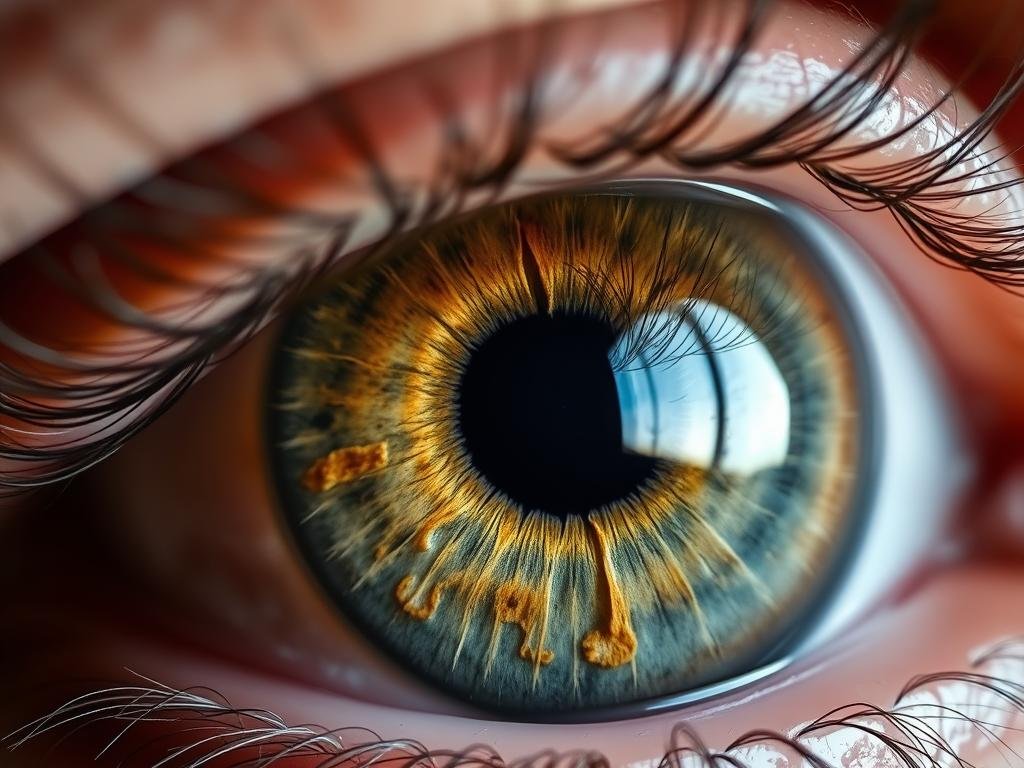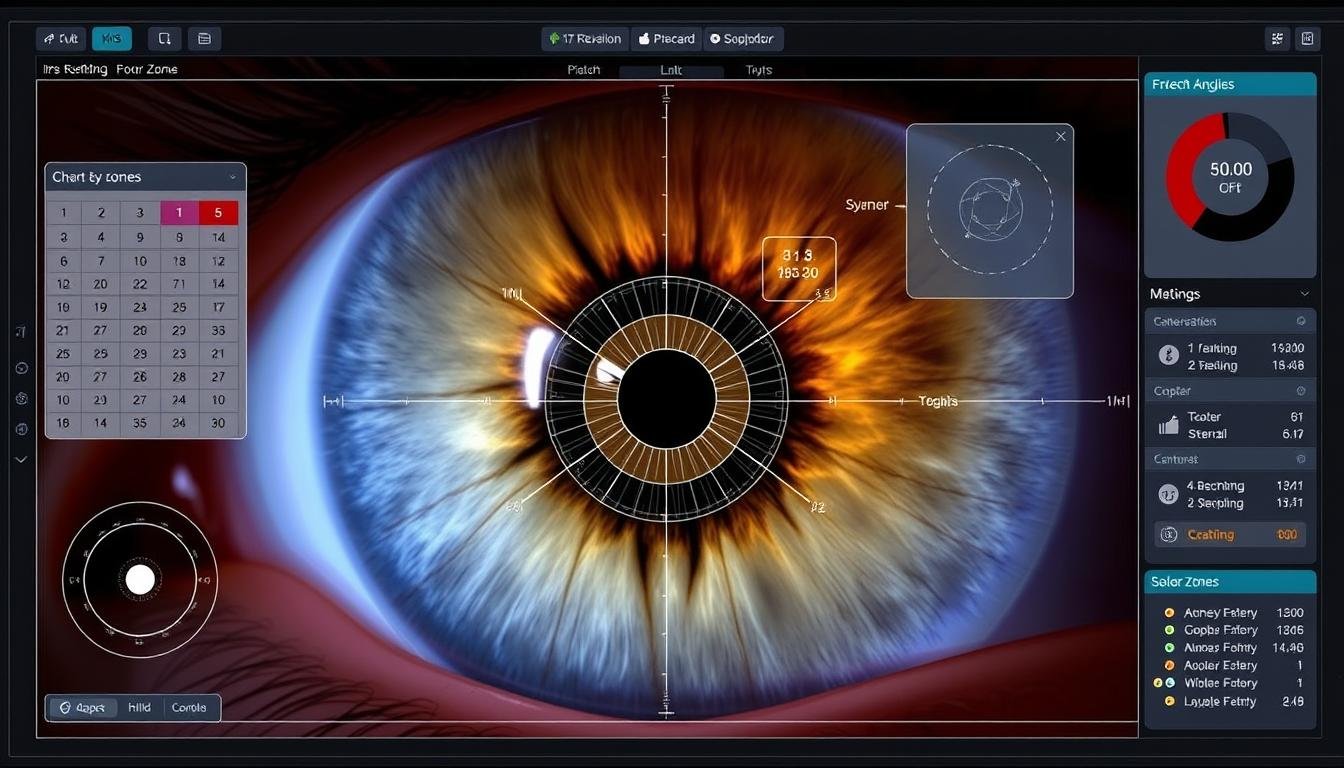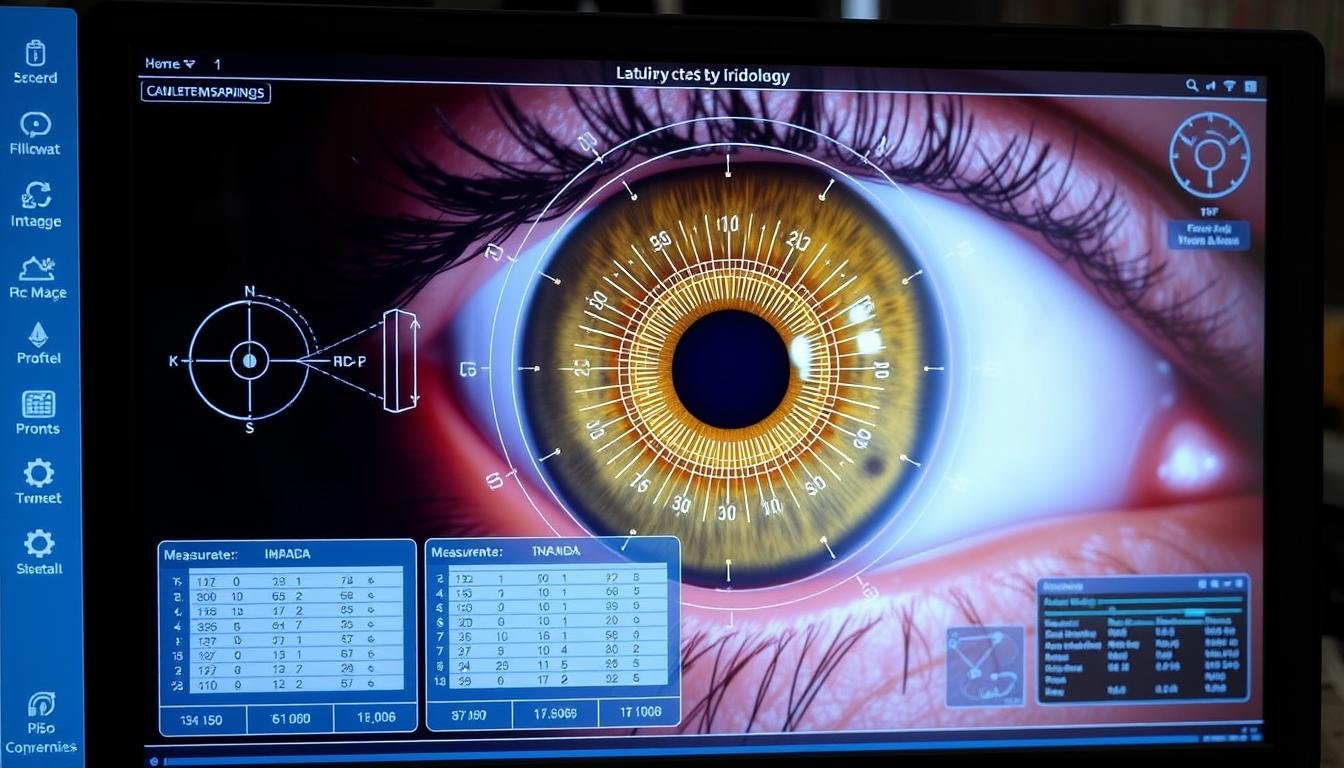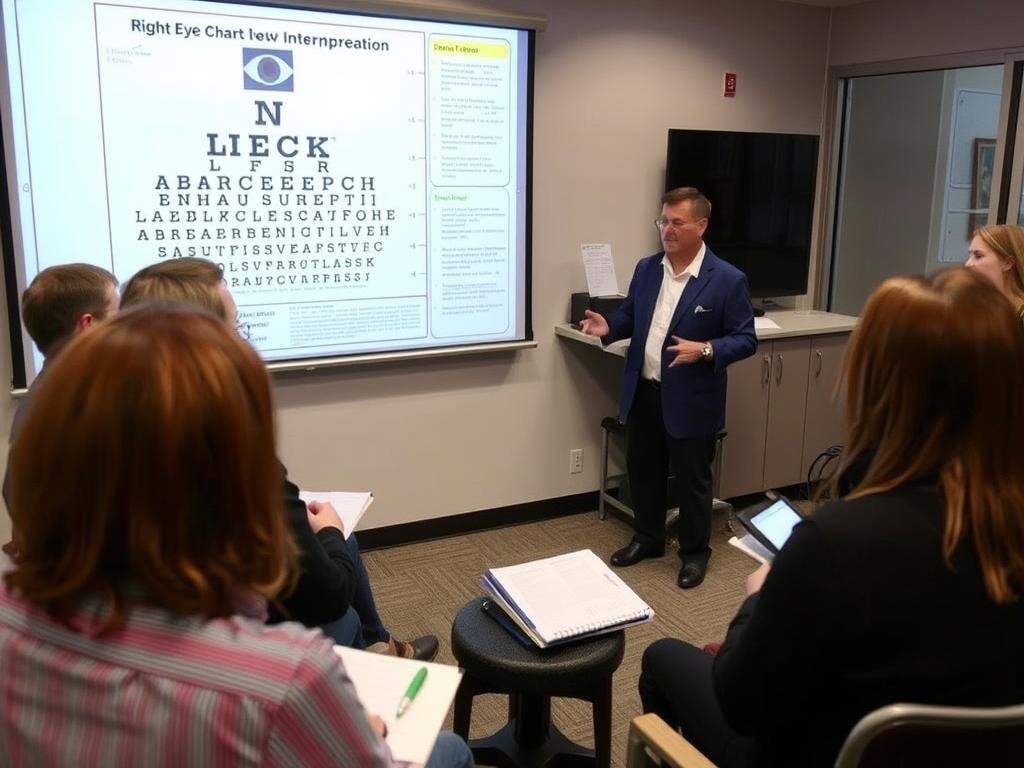The human iris contains remarkable details that, according to iridology practitioners, can reveal insights about your overall health. The Tableau des yeux droits serves as a critical tool in this practice, mapping specific areas of the iris to corresponding body systems. This guide explores how iridologists interpret these intricate patterns and what your right iris might be revealing about your wellbeing.
A certified iridologist analyzing iris patterns using a specialized Tableau des yeux droits
Understanding Iridology and the Tableau des yeux droits
Iridology is the study of the iris’s color, patterns, and other characteristics to evaluate a person’s health status. This practice dates back to the 1800s, though some claim its origins extend to ancient Egypt and Greece. The Tableau des yeux droits is a specialized mapping tool that divides the iris into zones corresponding to different organs and body systems.
Unlike conventional medical diagnostics, iridology doesn’t claim to identify specific diseases. Instead, practitioners use the Tableau des yeux droits to detect areas of inflammation, toxin accumulation, or constitutional strengths and weaknesses. This information can complement other health assessments and guide preventative health strategies.


Standard Tableau des yeux droits showing organ and system correlations
Historical Development of the Tableau des yeux droits
The modern Tableau des yeux droits evolved through several iterations. Hungarian physician Ignatz von Peczely is often credited with developing the first systematic iris chart in the 1800s. The story suggests he noticed changes in an owl’s iris after it suffered a broken leg. This observation led him to create detailed iris charts mapping body regions.
Dr. Bernard Jensen further refined these charts in the 20th century, creating the widely used Tableau des yeux droits that many practitioners still reference today. His work established the foundation for contemporary iridology practice in North America and worldwide.
Anatomy of the Tableau des yeux droits: Zones and Interpretations
Le Tableau des yeux droits divides the iris into numerous zones, each corresponding to specific body systems and organs. Understanding these zones is essential for proper iridological assessment.

Detailed view of iris markings interpreted using the Tableau des yeux droits
Key Zones on the Tableau des yeux droits
| Zone Location |
Corresponding Body System |
Significance in Iridology |
| Right Outer Iris |
Peau, système lymphatique |
Indicates elimination capacity and immune function |
| Upper Right Quadrant |
Cerveau, tête, sinus |
Reflects cognitive function and upper respiratory health |
| Lower Right Quadrant |
Digestive Organs, Liver |
Shows digestive efficiency and detoxification ability |
| Inner Ring (Pupillary Zone) |
Stomach, Intestines |
Indicates digestive strength and potential sensitivities |
| Middle Ring (Ciliary Zone) |
Circulatory System, Muscles |
Reflects metabolic activity and circulation quality |
Unlike the left eye chart, which typically represents the left side of the body, the Tableau des yeux droits corresponds primarily to the right side and certain specific organs. Some iridologists believe the right iris has stronger connections to the liver, gallbladder, and ascending colon.
Diagnostic Methods Using the Tableau des yeux droits
Iridologists employ several techniques when using the Tableau des yeux droits to assess health patterns. These methods involve careful examination of iris characteristics and correlation with the chart’s mapped zones.

Modern iridology examination using digital imaging and Tableau des yeux droits logiciel
Key Indicators on the Tableau des yeux droits
When examining the iris against the Tableau des yeux droits, practitioners look for several specific markers:
Color Variations
The base color of the iris (blue, brown, mixed) provides information about genetic predispositions. On the Tableau des yeux droits, color changes within specific zones may indicate inflammation or congestion in the corresponding organ.
Fiber Structures
The arrangement of iris fibers reveals constitutional strength. Straight, evenly spaced fibers suggest good vitality, while separated or irregular fibers in areas of the Tableau des yeux droits may indicate weakness in those systems.
Markings and Signs
Specific markings like lacunae (pit-like formations), crypts, and radii solaris (spoke-like lines) correspond to different health conditions when mapped to the Tableau des yeux droits.
Caractéristiques des élèves
The size, shape, and reaction of the pupil provide additional information about nervous system function and adrenal health when interpreted alongside the Tableau des yeux droits.

Computer-assisted analysis using digital Tableau des yeux droits mapping
Discover What Your Iris Reveals
Our certified iridologists use advanced Tableau des yeux droits analysis to identify potential health patterns. Book a consultation to learn what your iris may be telling you about your wellbeing.
Schedule Your Iris Analysis
Case Studies: The Tableau des yeux droits en pratique
To better understand how the Tableau des yeux droits works in real-world applications, let’s examine some anonymized case studies from professional iridology practice.
Case Study: Digestive Health Assessment
A 42-year-old client came in with chronic digestive discomfort. The iridologist examined the client’s right iris, focusing on the zones in the Tableau des yeux droits corresponding to the digestive system.
The examination revealed several lacunae (dark spots) in the intestinal zone of the right iris. According to the Tableau des yeux droits, these markings suggested potential inflammation in the intestinal tract. The practitioner recommended dietary modifications, specific herbs, and probiotics.
After three months, the client reported significant improvement in digestive comfort. A follow-up iris examination showed subtle changes in the previously identified areas.

Before and after comparison of digestive zone markings on the Tableau des yeux droits
Case Study: Liver Function Analysis
A 55-year-old client sought iridology assessment after experiencing fatigue and skin issues. The Tableau des yeux droits examination focused on the liver zone, which is particularly prominent in right iris analysis.
The iridologist noted a yellowish discoloration in the liver zone and several radii solaris (spoke-like lines) extending from the pupil through this area. According to Tableau des yeux droits interpretation, these signs suggested potential liver congestion and toxin accumulation.
The client was advised on a gentle liver support protocol including dietary changes and specific herbs. After following the recommendations for two months, the client reported improved energy and clearer skin.
Comparing the Tableau des yeux droits with Other Diagnostic Tools
To understand the value and limitations of the Tableau des yeux droits, it’s helpful to compare it with other diagnostic approaches, both conventional and alternative.
| Diagnostic Method |
Primary Focus |
Avantages |
Limites |
| Tableau des yeux droits Analyse |
Constitutional patterns, organ system relationships |
Non-invasive, holistic overview, preventative insights |
Not diagnostic of specific diseases, requires skilled interpretation |
| Left Eye Chart Analysis |
Left side organs, different constitutional aspects |
Complements right eye analysis, focuses on different body systems |
Similar limitations to right eye analysis |
| Blood Tests |
Biochemical markers, specific disease indicators |
Quantitative, specific, medically validated |
Invasive, point-in-time measurement, may miss functional issues |
| Medical Imaging (X-ray, MRI) |
Structural abnormalities, tissue changes |
Detailed visualization of internal structures |
Expensive, may involve radiation, primarily structural focus |

Comparison of different iridology charts including the standard Tableau des yeux droits
While conventional medical diagnostics focus on identifying specific diseases, the Tableau des yeux droits in iridology aims to reveal patterns and tendencies that may precede disease development. Many practitioners view these approaches as complementary rather than competing.
Integrate Iridology Into Your Health Journey
Our holistic practitioners combine Tableau des yeux droits analysis with other assessment methods for a comprehensive health evaluation.
Book a Comprehensive Assessment
Modern Applications of the Tableau des yeux droits
Today’s iridologists have integrated technology and contemporary health knowledge with traditional Tableau des yeux droits analysis, creating more sophisticated applications.

Advanced digital software for Tableau des yeux droits analyse
Digital Iridology and the Tableau des yeux droits
Digital cameras with high-resolution macro capabilities now allow for detailed iris photography. Specialized software can overlay the Tableau des yeux droits onto these images, helping practitioners make more precise observations and maintain records of changes over time.
Some advanced systems even incorporate artificial intelligence to identify patterns and correlations between iris signs and health conditions, though these technologies are still evolving and require skilled human interpretation.
Integrative Health Applications
Many holistic health practitioners now incorporate Tableau des yeux droits analysis as part of a broader assessment that may include:
- Nutritional evaluation and personalized dietary recommendations
- Herbal protocol development based on constitutional patterns
- Detoxification program design targeting specific organ systems
- Stress management strategies addressing nervous system patterns
- Preventative health planning based on identified tendencies

Integrative health consultation using Tableau des yeux droits findings
Frequently Asked Questions About the Tableau des yeux droits
How does the Tableau des yeux droits differ from the left eye chart?
While both charts map the iris to body systems, the Tableau des yeux droits typically corresponds more strongly to the right side of the body and certain specific organs like the liver and gallbladder. The left eye chart often relates more to the left side and organs like the heart and spleen. Some practitioners believe the right eye represents more “masculine” or active energy, while the left represents “feminine” or receptive energy, though these interpretations vary among different iridology schools.
Est Tableau des yeux droits analysis scientifically proven?
Conventional medicine does not currently recognize iridology as a validated diagnostic method. Research results have been mixed, with some studies showing correlations between iris signs and certain health conditions, while others have not found significant associations. Many practitioners view the Tableau des yeux droits as a complementary tool rather than a replacement for medical diagnosis. It’s best used as part of a holistic health assessment rather than as a standalone diagnostic method.
How long does a Tableau des yeux droits analysis take?
A comprehensive iris analysis using the Tableau des yeux droits typically takes 30-60 minutes for the initial consultation. This includes photography of the iris, analysis of the findings, and discussion of the results. Follow-up sessions are usually shorter, focusing on changes and progress. Some practitioners offer brief screenings that take only 15-20 minutes but provide less detailed information.
Can the Tableau des yeux droits show changes in health over time?
Yes, iridologists believe that certain aspects of the iris can change over time, particularly in the areas of acquired markings and coloration. The basic structure and constitutional patterns shown on the Tableau des yeux droits remain relatively stable, but signs of acute conditions, inflammation, or healing processes may show changes. Digital photography allows practitioners to document and compare these changes during follow-up visits.

Educational workshop on Tableau des yeux droits interpretation techniques
Expérience Tableau des yeux droits Analyse
Discover what your iris may reveal about your health with a professional Tableau des yeux droits analysis. Our certified iridologists combine traditional wisdom with modern techniques to provide insights into your constitutional patterns and potential health tendencies.

Our professional consultation environment for Tableau des yeux droits analyse
The Future of Tableau des yeux droits Analysis in Holistic Health
As interest in preventative and holistic health continues to grow, the Tableau des yeux droits remains a fascinating tool for those seeking to understand their body’s patterns and tendencies. While not a replacement for medical care, iridology offers a unique perspective that many find valuable on their health journey.
Whether you’re curious about what your iris might reveal or seeking to complement your current health practices, Tableau des yeux droits analysis provides a non-invasive window into your body’s constitutional patterns. Consider scheduling a consultation with a certified iridologist to explore this ancient yet evolving practice.
Commencez votre voyage en iridologie aujourd'hui
Take the first step toward understanding what your iris reveals about your health with our comprehensive Tableau des yeux droits analysis.
Book Your Consultation Now
























